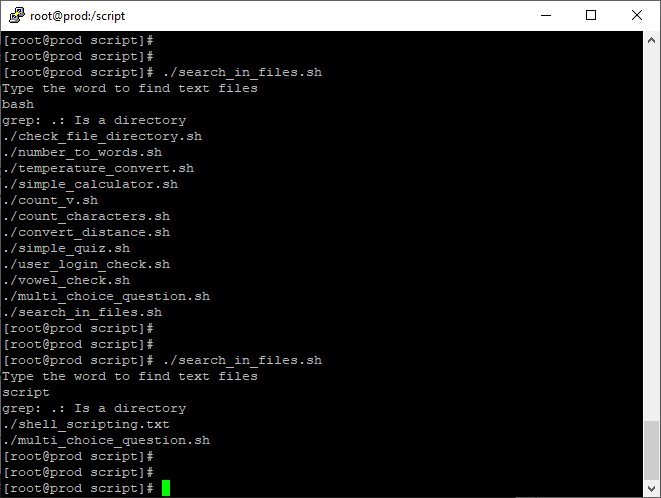

grep has a lot of settings that govern how it behaves.

In this tutorial, you will use grep command that looks for lines that match a pattern in one or more input files and outputs. grep reads from the standard input, which is usually the output of another command, if no files are specified. Grep looks for lines that match a pattern in one or more input files and outputs each matching line to standard output. Also, print error if the input was not valid.The grep command, which stands for "global regular expression print," is one of Linux's most powerful and widely used commands. In the end, we’ll print the file with the replacement made and end the script. If you just want to replace a single line, you can use a line number with +0 indicating only one line and so on. The above command starts with the line number and stops until the counter reaches the value minus one i.e the counter is a 0 based index. The sed command can be used according to the use case and as peer substitution. The above command substitutes the string from the 4th till the 11th line(4+7=11th line).

We can also specify the changes to be made only to specified lines using the following format : sed -i "4,+7 s|$old|$new|g" $file The g parameter indicates applying a substitution along the entire line. The s keyword specifies that the operation performed in the following command is substitution. The -i parameter makes changes directly to the original file name provided at the end. The above is a SED command that takes the three variables in bash and replaces the string in the entire file. We can now replace the old string with the new string using the sed command in the following format : sed -i "s|$old|$new|g" $file It will be the main aspect of replacing the string operation. The sed command stands for stream editor, and is quite a powerful tool for editing files or texts in a quick way using commands and without opening a text editor. The main aspect of replacing the string in the file is covered in the next section. In the above code, we have made an if-else block that prompts a y/n question and does the replacement accordingly. Read -p "Enter the number of lines after start to end the replacement : " end # replace string in between mentioned lines only Read -p "Enter the line number to start replacement from : " start Read -p "Do you want to replace the string in entire file ? (y/n) : " ynĮlif ] then Read -p "Enter the new word to be replaced : " newĮcho -e "\nFile" $file "before replacement\n\n" Read -p "Enter the old word to be replaced : " old If it’s yes, replace the string in the entire file, else input the start and end lines of the file where the string needs to be replaced. First, we’ll replace the string in the entire file, as a yes/no question. For that we can make use of if-else conditional statements. Read -p "Enter the new string to be replaced : " new Replacement choice (if/else)Īfter the string and file input, we need to prompt the user to replace the string in the entire file or in between specific lines in the file. Read -p "Enter the old string to be replaced : " old We will use the read function that prompts the user with an appropriate message and store it in the variable. Also, we’ll need to input the actual strings to be replaced in the file. User Inputįirstly, we will need the name of the file with which we are going to perform the string replacement operation. Using the SED command to actually replace the strings and finally printing out the file. First of all, the user input for the substituted strings and then the choice of a replacement in the block or entire file. Finally, printing the changes in the file. We’ll be making use of the sed command to make the actual replacement. So, for that, we’ll need an if-else condition for checking for the entire file string replacement or a specific part. We can replace the string in the entire file or a specific part mentioned by start and end lines. We need to input the file name, the existing string, and the new string to be substituted by the user. The approach to string replacement in a file is quite simple and straightforward.
Find word in file bash how to#
How to Hack WPA/WPA2 WiFi Using Kali Linux?.Mutex lock for Linux Thread Synchronization.SORT command in Linux/Unix with examples.AWK command in Unix/Linux with examples.Sed Command in Linux/Unix with examples.ISRO CS Syllabus for Scientist/Engineer Exam.ISRO CS Original Papers and Official Keys.GATE CS Original Papers and Official Keys.


 0 kommentar(er)
0 kommentar(er)
